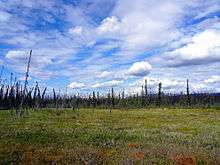Robert Campbell Highway
| ||||
|---|---|---|---|---|
| Yukon Highway 4 | ||||
| Route information | ||||
| Maintained by Yukon DOH&PW | ||||
| Length: | 362 mi (583 km) | |||
| Major junctions | ||||
| West end: |
| |||
|
| ||||
| East end: |
| |||
| Highway system | ||||
|
Territorial highways in Yukon
| ||||


Yukon Highway 4, also known as the Robert Campbell Highway or Campbell Highway, is a road between Watson Lake, Yukon on the Alaska Highway to Carmacks, Yukon on the Klondike Highway. It is 583 km (362 mi) long and mostly gravel-surfaced. It serves the communities of Faro and Ross River and intersects the Canol Road near Ross River. The highway is named for Robert Campbell, a nineteenth century Hudson's Bay Company fur trader and explorer.
The first portion of the Robert Campbell Highway, between Watson Lake and Miner Junction, was built in the early 1960s as part of the project to complete road access to Tungsten, Northwest Territories. The portion east and north of Miner Junction is now known as the Nahanni Range Road and Yukon Territorial Highway #10.
During the late 1960s and continuing to 1971, highways were built to connect Carmacks with Ross River, with a spur road to Faro to serve the new lead-zinc mine that opened in 1969. Additional road work was also completed between Ross River and Miner Junction. The completed road complements the Canol Road, providing two loops and bringing year-round access to Ross River.
The Campbell Highway is mostly gravel, and the most improved section is between Carmacks and Faro, where it has taken the most abuse from trucks hauling ore to Whitehorse and beyond.
The highway was originally route 9, but became route 4 in 1978. For travellers from the south whose destination is Dawson City, this route is some 20 miles shorter than going through Whitehorse. However, many area users consider the route inferior, usually narrow, and sometimes hazardous.
